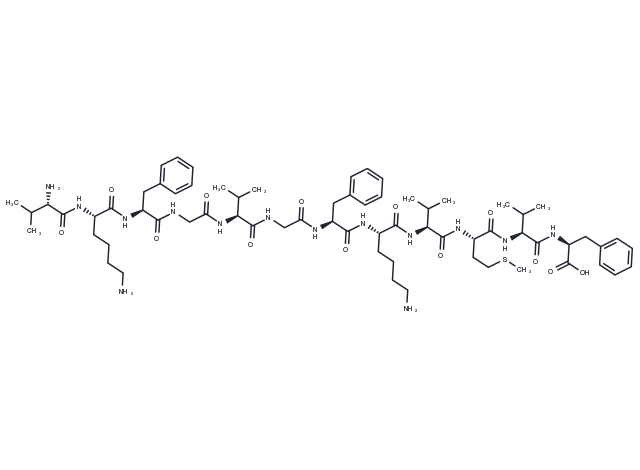keep away from moisture
Powder: -20°C for 3 years | In solvent: -80°C for 1 year

CALP2 acetate is an antagonist of calmodulin showing high affinity for binding to the CaM EF-hand/Ca2+-binding site with a Kd of 7.9 µM. CALP2 acetate potently inhibits of adhesion and degranulation. CALP2 acetate is also a strong activator of alveolar macrophages. CALP2 acetate inhibits CaM-dependent phosphodiesterase activity and increases intracellular Ca2+ concentrations.

| Pack Size | Availability | Price/USD | Quantity |
|---|---|---|---|
| 1 mg | In stock | $ 89.00 | |
| 5 mg | In stock | $ 185.00 | |
| 10 mg | In stock | $ 311.00 | |
| 25 mg | In stock | $ 559.00 | |
| 50 mg | In stock | $ 786.00 | |
| 100 mg | In stock | $ 1,120.00 |

| Description | CALP2 acetate is an antagonist of calmodulin showing high affinity for binding to the CaM EF-hand/Ca2+-binding site with a Kd of 7.9 µM. CALP2 acetate potently inhibits of adhesion and degranulation. CALP2 acetate is also a strong activator of alveolar macrophages. CALP2 acetate inhibits CaM-dependent phosphodiesterase activity and increases intracellular Ca2+ concentrations. |
| Targets&IC50 | Calmodulin:7.9 µM(Kd) |
| Molecular Weight | 1357.7 |
| Formula | C68H104N14O13S |
| CAS No. | TP1909L1 |
keep away from moisture
Powder: -20°C for 3 years | In solvent: -80°C for 1 year
You can also refer to dose conversion for different animals. More
bottom
Please see Inhibitor Handling Instructions for more frequently ask questions. Topics include: how to prepare stock solutions, how to store products, and cautions on cell-based assays & animal experiments, etc.
CALP2 acetate(261969-04-4 free base) TP1909L1 Metabolism Neuroscience PDE CaMK CALP2 acetate(261969 04 4 free base) CALP2 acetate(261969044 free base) inhibitor inhibit
